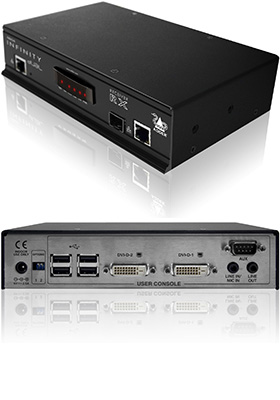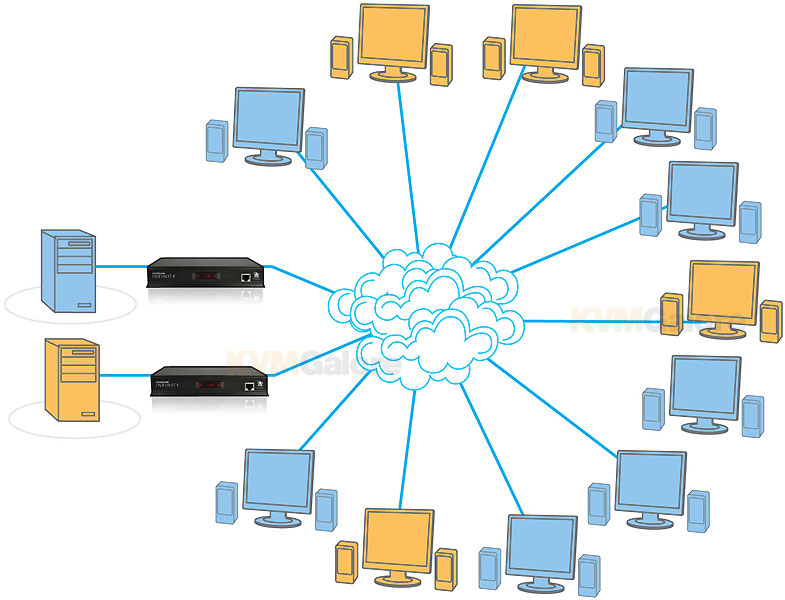Copyright © 2025 KVMGalore® - All rights reserved.

AdderLink INFINITY Dual 2000
Digital KVM and media extension and device switching over IP featuring dual head DVI or DisplayPort video, digital audio, USB true emulation and network multicast
Read more below...

1) AdderLink INFINITY Dual 2002T, Transmitter Model No. ALIF2002T-US  In stock
In stock

2) AdderLink INFINITY Dual 2020R, Receiver Model No. ALIF2020R-US  In stock
In stock

3) AdderLink INFINITY Dual 2020T, Transmitter Model No. ALIF2020T-US  In stock
In stock

4) AdderLink INFINITY Dual 2112T, Transmitter w/ VNC Model No. ALIF2112T-US  In stock
In stock
Dual-head DisplayPort or DVI video, audio and USB dual IP carrier type network (copper & fiber) over 1GbE IP network
pure digital media KVM extension and matrix over IP featuring dual head or dual link video, digital audio, USB true emulation, network multicast, device switching and EPG style user interface
 AdderLink INFINITY Dual allows you to build a flexible infrastructure, the likes of which have not been possible before. Locate computers anywhere you like, share connections to computers, watch the interactions others have with computers, share control, collaborate, switch computers, and so on.
AdderLink INFINITY Dual allows you to build a flexible infrastructure, the likes of which have not been possible before. Locate computers anywhere you like, share connections to computers, watch the interactions others have with computers, share control, collaborate, switch computers, and so on.
AdderLink INFINITY range is also the first of its kind to allow multicasting across your network.
AdderLink INFINITY Dual interfaces USB peripherals such as the keyboard, mouse or graphics tablet, together with DVI for the video display, over a layer 3, standard gigabit ethernet network, on copper or fiber.
AdderLink INFINITY Dual is fully compatible with AdderLink INFINITY and AIM Management Interface.
• AdderLink INFINITY Dual 2002T: Single-head 2560x1600 @ 60Hz DVI or dual-head 1920x1200 @ 60Hz DVI
• AdderLink INFINITY Dual 2020T: Dual-head 1920x1200 @ 60Hz DVI
• AdderLink INFINITY Dual 2112T: Single-head 2560x1600 @ 60Hz DVI or dual-head 1920x1200 @ 60Hz DVI and Real VNC
Compatibility
All AdderLink INFINITY (ALIF) Transmitter (Tx) and Receiver (Rx) models are fully compatible with one another, as long they are running the latest firmware, subject to feature limitations that only exists on one end or the other.
• Limitation example #1: Tx supports 4K resolution but the Rx only supports HD resolution, so you'd only get HD video on the Receiver unit.
• Limitation example #2: ALIF100T (HD video, full speed USB) connected to ALIF4001R (4K video, high speed and transparent USB) unit, so you'd only get HD video and HID USB support.
Compatibility Notes
1) ALIF1000s are only compatible with legacy AIM units (v3.3/v3.5). The rest of the models are compatible with AIM/ASP as long as they are all running the latest firmware.
2) Only AdderLink INFINITY (ALIF) 2102/2122 and 4001/4021 models can be used in un-managed mode.
3) AdderLink INFINITY (ALIF) 3000s models require AIM - they cannot be used in Point-to-Point topology or in un-managed mode.
Operation Modes
There are two modes in which AdderLink INFINITY system can be deployed:
Un-Managed Mode: Tx and Rx units are deployed in Many-to-One (Switching) or Many-to-Many (Matrix) configurations without the use of AdderLink INFINITY Manager (AIM) server. Only ALIF2102/2122 and ALIF4001/4021 models support Un-Managed mode, restricted to no more than 16 Tx units connected to any given Rx.
Managed Mode: Tx and Rx units are deployed in a network along with AdderLink INFINITY Manager (AIM) server. Many-to-one and many-to-many configurations with multiple users (Rx) being able to switch between as many hosts/Transmitters as they have rights to require the use of AdderLink INFINITY Manager (AIM) server (with the appropriate number of licenses to match the number of end-points).
Topology Deployments
There are four ways to connect AdderLink INFINITY endpoints together:
Point-to-Point (Extension): one Tx to one Rx, via direct cable or via a network switch, with the IP address of the Tx being ‘hard coded' into the Rx unit.
Point-to-Point configuration can be deployed as a direct (Tx to Rx) extension (limited to a distance of 328 feet), or through an Ethernet switch for longer distances.
Point-to-Point configuration does not require to be managed with AIM server.
One-to-Many (Sharing/Reverse KVM): Using multicast techniques, an unlimited number of Receivers can receive video and audio data streams from a single Transmitter unit. A maximum of twelve concurrent USB inputs (via multiple Receiver units) are permitted to a single Transmitter unit.
When there are multiple Receivers connected to the same Transmitter, the Tx does not know (or care) how many Receivers it has connected, 2 or 222. One to many (one Tx to many Rx) is always multicast so the Tx just "gives" the frames to its network switch and the switch has to deliver it to every Rx that needs the frame using IGMP snooping and IGMP querier.
One-to-Many configuration does not require to be managed with AIM server.
Many-to-One (Switching): Multiple Transmitters are connected to one Receiver, so that a user (Rx) can use its console to switch between targets (Tx).
Many-to-One (switching) configuration requires to be managed with AIM server, with the exception of ALIF2102/2122 and ALIF4001/4021 models.
ALIF2102/2122 and ALIF4001/4021 models support Many-to-One (Switching) without the use of AIM server (aka: Un-Managed mode), with a limit of 16 Tx units connected to any given Rx unit (being that the Rx OSD only has 16 entries). There is no limit to the number of Tx and Rx units on the network in Un-Managed mode, however. There could be 100 Transmitters on the network, but each user (Rx) can only connect to 16 of those. So one user could have their own 16 computers and a second user can have their own 16 computers, or the two users can overlap, but they wouldn't be able to connect to all 100 host computers.
Many-to-Many (Matrix): Multiple Transmitters are connected to multiple Receivers, so that many users (Rx) can use their consoles to switch between many targets (Tx).
Many-to-Many (Matrix) configuration requires to be managed with AIM server, with the exception of ALIF2102/2122 and ALIF4001/4021 models.
ALIF2102/2122 and ALIF4001/4021 models support Many-to-Many (Matrix) configuration without the use of AIM server (aka: Un-Managed mode), with a limit of 16 Tx units connected to any given Rx unit (the Rx OSD only has 16 entries). There is no limit to the number of Tx and Rx units on the network in Un-Managed mode, however. There could be 100 Transmitters on the network, but each user (Rx) can only connect to 16 of those. So one user could have their own 16 computers and a second user can have their own 16 computers, or the two users can overlap, but they wouldn't be able to connect to all 100 host computers.










